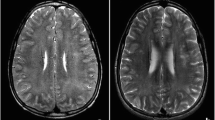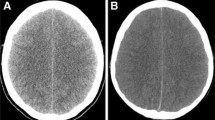Abstract
MPI-CDG (formally called CDG 1b), caused by phosphomannose isomerase (MPI) deficiency, leads to hypoglycaemia, protein losing enteropathy, hepatopathy, and thrombotic events, whereas neurologic development remains unaffected. Dietary supplementation of mannose can reverse clinical symptoms by entering the N-glycosylation pathway downstream of MPI. When oral intake of mannose in patients with MPI-CDG is not possible, e.g. due to surgery, mannose has to be given intravenously. We report a patient with MPI-CDG on intravenous mannose therapy that showed severe depression of consciousness and seizures without apparent cause. EEG and cranial MRI findings were compatible with metabolic coma whereas extended laboratory examinations including repeated blood glucose measurements were normal. Importantly, an intravenous bolus of glucose immediately led to clinical recovery and EEG improvement. Mannose did not interfere with glucose measurement in our assay. We suggest that in patients with MPI-CDG, intravenous mannose infusion can lead to intracellular ATP deprivation due to several mechanisms: (1) in MPI deficiency, mannose 6-P cannot be isomerised to fructose 6-P and therefore is unavailable for glycolysis; (2) animal data has shown that accumulating intracellular mannose 6-P inhibits glycolysis; and (3) elevated intracellular mannose 6-P may induce an ATP wasting cycle of dephosphorylation and rephosphorylation (“honey bee effect”). The mannose-induced metabolic inhibition may be overcome by high-dose glucose treatment. We caution that, in patients with MPI-CDG, life-threatening central nervous system disturbances may occur with intravenous mannose treatment. These may be due to intracellular energy failure. Clinical symptoms of energy deficiency should be treated early and aggressively with intravenous glucose regardless of blood glucose levels.





Similar content being viewed by others
References
de la Fuente M, Penas PF, Sols A (1986) Mechanism of mannose toxicity. Biochem Biophys Res Commun 140:51–55
de Lonlay P, Seta N (2009) The clinical spectrum of phosphomannose isomerase deficiency, with an evaluation of mannose treatment for CDG-Ib. Biochim Biophys Acta 1792:841–843
de Lonlay P, Cuer M, Vuillaumier-Barrot S et al (1999) Hyperinsulinemic hypoglycemia as a presenting sign in phosphomannose isomerase deficiency: A new manifestation of carbohydrate-deficient glycoprotein syndrome treatable with mannose. J Pediatr 135:379–383
DeRossi C, Bode L, Eklund EA et al (2006) Ablation of mouse phosphomannose isomerase (Mpi) causes mannose 6-phosphate accumulation, toxicity, and embryonic lethality. J Biol Chem 281:5916–5927
Freinkel N, Lewis NJ, Akazawa S et al (1984) The honeybee syndrome - implications of the teratogenicity of mannose in rat-embryo culture. N Engl J Med 310:223–230
Harms HK, Zimmer KP, Kurnik K et al (2002) Oral mannose therapy persistently corrects the severe clinical symptoms and biochemical abnormalities of phosphomannose isomerase deficiency. Acta Paediatr 91:1065–1072
Niehues R, Hasilik M, Alton G et al (1998) Carbohydrate-deficient glycoprotein syndrome type Ib. Phosphomannose isomerase deficiency and mannose therapy. J Clin Invest 101:1414–1420
Sharma P, Eesa M, Scott JN (2009) Toxic and acquired metabolic encephalopathies: MRI appearance. Am J Roentgenol 193:879–886
Sols A, Cadenas E, Alvarado F (1960) Enzymatic basis of mannose toxicity in honey bees. Science 131:297–298
Wood FC Jr, Cahill GF Jr (1963) Mannose Utilization in Man. J Clin Invest 42:1300–1312
Author information
Authors and Affiliations
Corresponding author
Additional information
Communicated by: Jaak Jaeken
Competing interests: None declared.
Rights and permissions
About this article
Cite this article
Schroeder, A.S., Kappler, M., Bonfert, M. et al. Seizures and stupor during intravenous mannose therapy in a patient with CDG syndrome type 1b (MPI-CDG). J Inherit Metab Dis 33 (Suppl 3), 497–502 (2010). https://doi.org/10.1007/s10545-010-9252-x
Received:
Revised:
Accepted:
Published:
Issue Date:
DOI: https://doi.org/10.1007/s10545-010-9252-x




